At the end of this lesson-
1. You will be able to explain web page design and development.
2. You will be able to explain the importance of website publishing.
3. You will be able to explain the steps of website publishing.
4. You will be able to explain different types of hosting.
Go for Bangla Version
Web page design and development:
Web page design is the process of creating websites which is front end design. It encompasses several different aspects, including webpage layout, content production, and graphic design using the different technology and...
Read More
ICT HSC (English Version)
HTML Table related Questions and Answers – HSC ICT Chapter 4
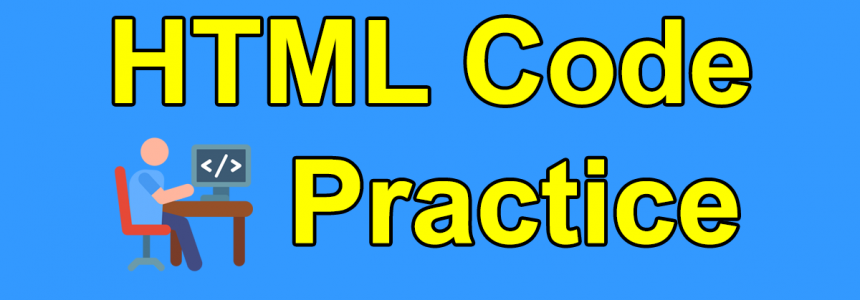
Go for Bangla Version
According to the stem answer the following questions:
c) Write HTML code for showing the table on the web page.
HTML CODE:
<html>
<body>
<table border="1">
<tr>
<th>Science</th>
<th>Commerce </th>
<th>Humanities </th>
</tr>
<tr>
<td>
<ol type="A">
<li>Physic</li>
<li>Chemistry</li>
<li>Math</li>
<li>Biology</li>
</ol>
</td>
<td>
<ul type="disc">
<li>...
Read More
Fourth Chapter Lesson-9: HTML code for creating table.
At the end of this lesson-
1. You will be able to create table on the web page.
2. You will be able to marge the rows of the table.
3. You will be able to marge the columns of the table.
Go for Bangla Version
Table Creation in HTML:
The purpose of creating a web page or website is to present any information globally. It is often necessary to present data and information in tabuler form. Lets see the table elements-
The <table> </table> tag defines an HTML table. An HTML table consists of the <table> element and one or more &...
Read More
Fourth Chapter Lesson-8: Adding Image and Creating Hyperlink on the web page.
At the end of this lesson-
1. You will be able to add image on the web page.
2. You will be able to create hyperlink on the web page.
3. You will be able to create hyperlink with image on the web page.
4. You will be able to add audio and video on the web page.
Go for Bangla Version
Adding Image on the web page:
Images can improve the design and the appearance of a web page. For adding pictures into the web page, we can use the <img> tag. The <img> tag is an empty tag which mean it has no ending tag (i.e. no </img>) associated with it. The...
Read More
Fourth Chapter Lesson-7: Ordered List, Unordered List, Description List
At the end of this lesson-
1. You will be able to create ordered list.
2. You will be able to create unordered list.
3. You will be able to create description list.
Go for Bangla Version
HTML List:
Sometimes information of web page needs to be published in a list or list form. That is, list items need to be numbered or expressed in bullet point form. There are three types of lists in HTML. They are-
Ordered List
Unordered List
Description List
Ordered List:
An ordered list starts with the <ol> tag. Each list item starts with the ...
Read More
Fourth Chapter Lesson-6: Heading tags, Paragraph tags, Formatting tags etc.
At the end of this lesson-
1. You will be able to explain the uses of different heading tags.
2. You will be able to explain the use of paragraph tag.
3. You will be able to explain the uses of different formatting tags.
4. You will be able to define different properties of the fonts.
Go for Bangla Version
Heading Tags:
Any content or article starts having a nice heading, provides the headline or the topic name of any document. Similarly, in HTML code also, different sizes of heading can be given on your web page. HTML allows six sizes for heading that uses eleme...
Read More
Fourth Chapter Lesson-5: Basic Concept of HTML.
At the end of this lesson-
1. You will be able to describe HTML.
2. You will be able to describe advantages and disadvantages of using HTML.
3. You will be able to explain HTML tag and it's type.
4. You will be able to explain HTML element and HTML attribute.
5. You will be able to explain the structure of a web page.
6. You will be able to describe necessary tools for creating web page.
Go for Bangla Version
Introduction to HTML:
HTML is an acronym which stands for Hyper Text Markup Language which is used for creating web pages and web applications. HTML describe...
Read More
Fourth Chapter Lesson-4: Website Structures (Linear, Tree, Web linked, Hybrid).
At the end of this lesson-
1. You will be able to explain different types of pages of a website.
2. You will be able to explain structure of websites.
3. You will be able to explain different types of website structures.
4. You will be able to analyze different types of website structures.
Go for Bangla Version
Website’s structure:
A website’s structure refers to how the website is set up, i.e. how the individual sub-pages are linked to one another. It is particularly important that crawlers can find all sub-pages quickly and easily when websites have a larg...
Read More
Fourth Chapter Lesson-3: IP Address & Different parts of URL.
At the end of this lesson-
1. You will be able to explain IP address.
2. You will be able to differentiate IPV4 and IPV6.
3. You will be able to describe different parts of URL or web address.
Go for Bangla Version
IP address:
An Internet Protocol address (IP address) is a logical numeric address that is assigned to every single computer, printer, switch, router or any other device of a TCP/IP-based network.
An IP address is a logical address that is used to uniquely identify every node in the network. Because IP addresses are logical, they can change.
...
Read More
Static Website and Dynamic Website
At the end of this lesson-
1. You will be able to explain static website and it's characteristics.
2. You will be able to describe advantages and disadvantages of static website.
3. You will be able to explain dynamic website and it's characteristics.
4. You will be able to describe advantages and disadvantages of dynamic website.
5. You will be able to differentiate static website and dynamic website.
Go for Bangla Version
Websites can be of two types:
Static Website
Dynamic Website
Static website:
A static website contains information th...
Read More
Fourth Chapter Lesson-1: Introduction to Web design and some terminologies about it.
At the end of this lesson-
1. You will be able to explain web design.
2. You will be able to explain some terminologies about web design.
Go for Bangla Version
Web Design:
Web design is the process of creating the layout of a web page or an entire website. This process focuses on aesthetic factors like layout, user interface and other visual imagery in order to make the website more visually appealing and easy to use. Web design makes use of various programs and tools in order to achieve the intended look, such as Dreamweaver, Photoshop and many others.
...
Read More
HSC ICT Chapter 6 : Comprehension Based Questions & Answers
How to write answers to a comprehension based question?
⇒ 'Comprehension' refers to the ability to understand the meaning of a topic. It can be the ability to understand any information, policy, formula, rule, procedure, process etc.
⇒ Perceptual level is the second level of thinking skills. This question is given in 'b'. Such questions do not directly ask for textbook-like details. So the student has to explain or describe the content in his own way.
⇒ Marks of comprehension based question will be 2. Out of which 1 is for knowledge and 1 is for comprehension.
⇒ Comprehension based q...
Read More
Sixth Chapter: Knowledge Based Questions & Answers
What is data?
What is information?
What is database?
What is attribute/field/column?
What is entity/record/tuple/row?
What is entity set/table?
What is DBMS?
What is database administrator?
What is query?
What is query language?
What is SQL?
What is DDL/DML?
What is data sorting?
What is indexing?
What is RDBMS?
What is key field?
What is candidate key?
What is primary key?
What is composite primary key?
What is foreign key?
What is database relationship?
What is database relation?
What is corporate database?
What is data...
Read More
Sixth Chapter Lesson-10: Database security.
At the end of this lesson-
1. You will be able to explain database security.
2. You will be able to explain different methods of data encryption.
Database Security: Protecting data from an unauthorized user in a database is called database security.
Database Security controls certain aspects:
Ensuring not to use data without permission.
Protecting database system from unknown users.
Controlling the use of disc.
Controlling the use of system resource.
Controlling the actions taken by the users.
Types of Database Security: Database security i...
Read More
Sixth Chapter Lesson-9: Corporate database and database in government organizations
At the end of this lesson-
1. You will be able to explain corporate database.
2. You will be able to describe the uses of database in government organizations.
Corporate database: Corporate database is related to any enterprise from starting the enterprise to the wind up off. It contains all the information related to all the activities of any business. It contains the data about the history of related industry. Corporate database helps entrepreneur and managers to take better decisions and for proper controlling over market related activities.
The following DBMS are used i...
Read More
Fifth Chapter Lesson-20: Function in C programming language
At the end of this lesson-
1. You will be able to explain function.
2. You will be able to explain library function and user defined function.
3. You will be able to explain the importance of using function.
4. You will be able to explain recursive function and it's advantages and disadvantages.
Function: A function is a group of statements that together perform a specific task. A function that take inputs, do some process and produces a output.
Syntax of a function:
Function declaration: A function declaration tells the compiler about a function's name, return...
Read More
Fifth Chapter Lesson-19: Array in C programming language
At the end of this lesson-
1. You will be able to explain array.
2. You will be able to explain types of array.
3. You will be able to declare an array and assign the value of that array.
4. You will be able to explain the advantages and disadvantages of using array.
Array: Array is a kind of data structure which is a collection of variables of same data type. Array is called derived data type. An array is used to store group of data of same data type. Types of array-
1. One-dimensional array
2. Multidimensional array (two-dimensional,...)
ONE-D...
Read More
Fifth Chapter Lesson-18: ‘continue’ statement, ‘break’ statement and ‘goto’ statement
At the end of this lesson-
1. You will be able to write a program using 'continue' statement.
2. You will be able to write a program using 'break' statement.
3. You will be able to write a program using 'goto' statement.
'continue' statement: The continue statement is used inside loops to bring the program control to the beginning of the loop. When a continue statement is encountered inside a loop, statement skips some lines of code inside the loop body and continues with the next iteration. It is mainly used for a condition so that we can skip some code for a particula...
Read More
Fifth Chapter Lesson-17: Loop Control Statement Related programs.
At the end of this lesson-
1. You will be able to write a program for printing numbers from 1 to 10. Or
You will be able to write a program for printing the 1 2 3 4 5 6 7 8 9 10 Sequence.
2. You will be able to write a program for printing numbers from 1 to n. Or
You will be able to write a program for printing the 1 2 3 4 - - - - n Sequence.
3. You will be able to write a program for printing odd numbers from 1 to 10. Or
You will be able to write a program for printing the 1 3 5 7 9 Sequence.
4. You will be able to write a program for printing odd numb...
Read More
Fifth Chapter Lesson-16: Loop Control Statements in C programming language
At the end of this lesson-
1. You will be able to explain loop.
2. You will be able to explain loop control statements.
3. You will be able to explain for, while and do-while loop control statements.
4. You will be able to differentiate between while and do-while loop control statements.
Loop: Loops are used in programming to repeat a block of code multiple times or until a specific condition is false.
Types of loop:
1. Infinite loop: The loop that repeat continuously and never end. A loop becomes an infinite loop if a condition never becomes false.
2. Fin...
Read More
Fifth Chapter Lesson-15: Conditional Control Statement Related programs
At the end of this lesson-
1. You will be able to write a program for determining an integer number is whether even or odd.
2. You will be able to write a program for determining a number is whether positive or negative.
3. You will be able to write a program for determining a year is whether leap year or not leap year.
4. You will be able to write a program for determining larger number between two numbers.
5. You will be able to write a program for determining LCM of two integer numbers.
6. You will be able to write a program for determining GCD of two integer numbers.
...
Read More
Fifth Chapter Lesson-14: Conditional Control Statements in C language
At the end of this lesson-
1. You will be able to explain control statement.
2. You will be able to explain different control statements.
3. You will be able to explain conditional control statement details.
4. You will be able to write program using conditional control statement.
Control statements: A control statement is a statement that determines whether other statements will be executed. Control statements control the flow of program. They make it possible to make decisions, to perform tasks repeatedly or to jump from one section of code to another.
Contr...
Read More
Fifth Chapter Lesson-13: Basic Mathematical problem related program
At the end of this lesson-
1. You will be able to write a program for adding two numbers.
2. You will be able to write a program for subtracting two numbers.
3. You will be able to write a program for multiplying two numbers.
4. You will be able to write a program for dividing two numbers.
5. You will be able to write a program for converting temperature from Celsius to Fahrenheit.
6. You will be able to write a program for converting temperature from Fahrenheit to Celsius.
7. You will be able to write a program for determining area of a triangle where base and height ha...
Read More
Fifth Chapter Lesson-12: Input and output functions in C programming language
At the end of this lesson-
1. You will be able to use input and output functions in c program.
2. You will be able to describe formatted and un-formatted input-output functions.
3. You will be able to explain printf() and scanf() functions details.
Input and Output functions in C programming language:
Input means to provide some data to be used in the program and Output means to display data on screen or write the data to a file. Input functions are used to read any given input and Output functions are used to display data on screen.
C programming language pro...
Read More
Fifth Chapter Lesson-11: Operators and expressions of C language
At the end of this lesson-
1. You will be able to explain operators.
2. You will be able to describe different operators and their uses.
3. You will be able to explain expressions.
4. You will be able to explain the precedence and associativity of operators.
Operator: An operator is a symbol that tells the compiler to perform specific mathematical or logical operations. In other words we can say that an operator operates the operands.The data items on which operators act upon are called operands.Operators are used in programs to manipulate constant and operands.
...
Read More
Fifth Chapter Lesson-10: Data type, token, keyword, constant and variable
At the end of this lesson-
1.You will be able to explain data type and it's classification.
2. You will be able to explain memory range and format specifier of data type.
3. You will be able to describe the keywords of 'C' programming language.
4. You will be able to declare variable and constant in 'C' program.
5. You will be able to describe the rules of declaring variable in 'C' program.
Data Type: A data type specifies the type of data that a variable can store such as integer, floating, character, etc. Each data type requires different amounts of memory an...
Read More
Basic concept of ‘C’ programming language
At the end of this lesson-
1.You will be able to explain basic concept of 'C' programming language.
2. You will be able to describe the characteristics of 'C' programming language.
3. You will be able to explain the basic structure of a 'C' program.
4.You will be able to analyze different parts of a 'C' program.
Basic concept of 'C' programming language: 'C' is a general-purpose, structured or procedure, high-level language that was originally developed by Dennis M. Ritchie to develop the UNIX operating system at Bell Labs. It is also popular as mid level language. C w...
Read More
Fifth Chapter Lesson-8: Program Design Model.
At the end of this lesson-
1.You will be able to explain program design model.
2. You will be able to explain structured or procedure programming model.
3. You will be able to explain object oriented programming model.
4. You will be able to explain visual programming model.
5. You will be able to explain event driven programming model.
Program Design Model: Some special rules or methods or processes are followed by the programmer to develop a program to make it more efficient and easier to understand and modify.These rules or processes or methods are called progr...
Read More
Fifth Chapter Lesson-7: Loop Related algorithm & flowchart.
At the end of this lesson-
1. You will be able to write algorithm and flowchart for printing numbers from 1 to 10. Or
You will be able to write algorithm and flowchart for printing the 1 2 3 4 5 6 7 8 9 10 Sequence.
2. You will be able to write algorithm and flowchart for printing numbers from 1 to n. Or
You will be able to write algorithm and flowchart for printing the 1 2 3 4 - - - - n Sequence.
3. You will be able to write algorithm and flowchart for printing odd numbers from 1 to 10. Or
You will be able to write algorithm and flowchart for printing the 1 3 5 7 9 Sequence.
4. You wil...
Read More
Fifth Chapter Lesson-6: Conditional Control Statement Related algorithm & flowchart.
At the end of this lesson-
1. You will be able to write algorithm & flowchart for determining an integer number is whether even or odd.
2. You will be able to write algorithm & flowchart for determining a number is whether positive or negative.
3. You will be able to write algorithm & flowchart for determining a year is whether leap year or not leap year.
4. You will be able to write algorithm & flowchart for determining larger number between two numbers.
5. You will be able to write algorithm & flowchart for determining LCM of two integer numbers.
6. You will be able...
Read More
Fifth Chapter Lesson-5: Basic Mathematical problem related algorithm & flowchart.
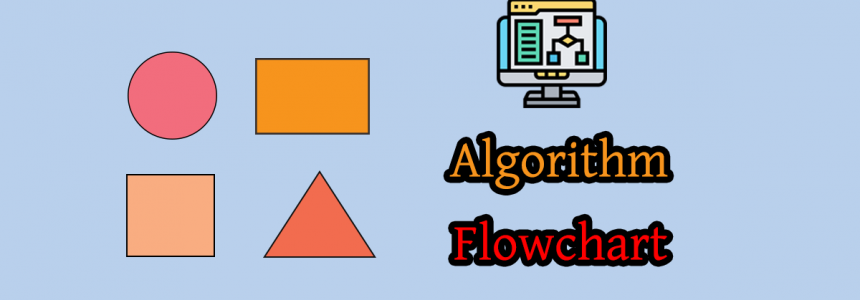
At the end of this lesson-
1. You will be able to write algorithm & flowchart for adding two numbers.
2. You will be able to write algorithm & flowchart for subtracting two numbers.
3. You will be able to write algorithm & flowchart for multiplying two numbers.
4. You will be able to write algorithm & flowchart for dividing two numbers.
5. You will be able to write algorithm & flowchart for converting temperature from Celsius to Fahrenheit.
6. You will be able to write algorithm & flowchart for converting temperature from Fahrenheit to Celsius.
7. You will be abl...
Read More
Algorithm, Flowchart and Pseudo code
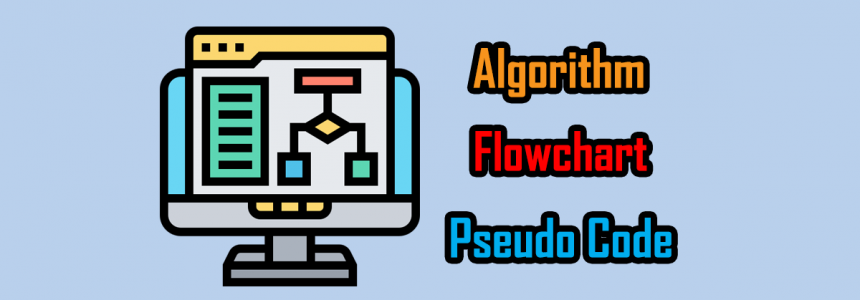
At the end of this lesson-
1. You will be able to explain algorithm and flowchart.
2. You will be able to describe the conditions for writing algorithm.
3. You will be able to describe the advantages of writing algorithm and flowchart.
4. You will be able to describe the rules of creating flowchart.
5. You will be able to describe the use of symbols used in flowchart.
Go for Bangla Version
Algorithm:
An algorithm is a sequence of finite number of logical steps to solve a particular problem or algorithm is an ordered set of unambiguous logical steps that produces a res...
Read More
Fifth Chapter Lesson-3: Program organization and Steps of developing a Program.
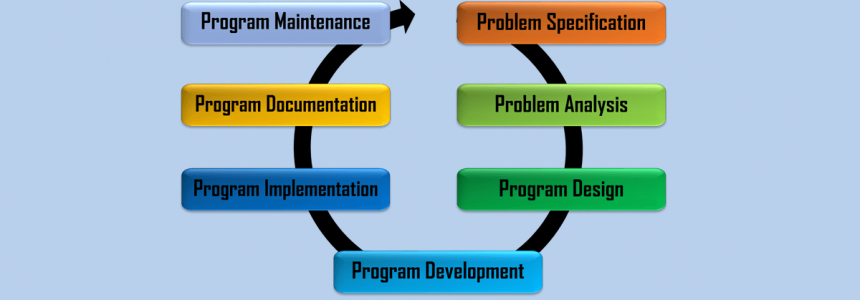
At the end of this lesson-
1. You will be able to explain the organization of program.
2. You will be able to describe the characteristics of a standard program.
3. You will be able to explain the steps of developing a program.
Go for Bangla Version
Organization of Program:
Every complete program has three essential parts which make a program standard through interaction with each other parts. These parts are-
Input: Every program should have input system to process.
Process: Every program should have processing system taking inputs from the user.
Output: Ev...
Read More
Translator Programs । Compiler, Interpreter & Assembler
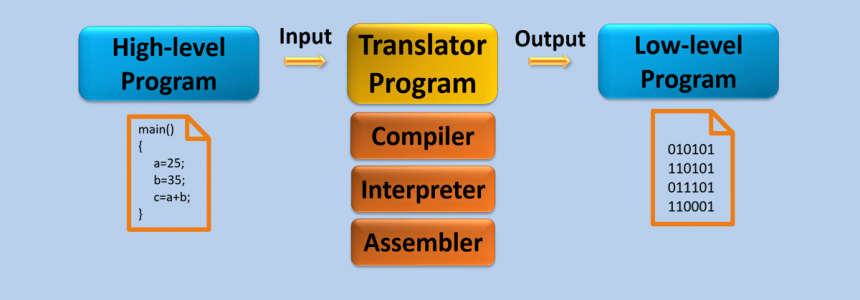
At the end of this lesson-
1. You will be able to explain translator program.
2. You will be able to describe compiler and it's function, advantages and disadvantages.
3. You will be able to describe interpreter and it's function, advantages and disadvantages.
4. You will be able to differentiate interpreter over compiler.
5. You will be able to describe Assembler and it's functions.
Go for Bangla Version
Translator Program:
Any machine including computer can understand only 0 and 1. This means that only instructions or programs written in machine language can be unders...
Read More
Programming languages of different generations and levels.
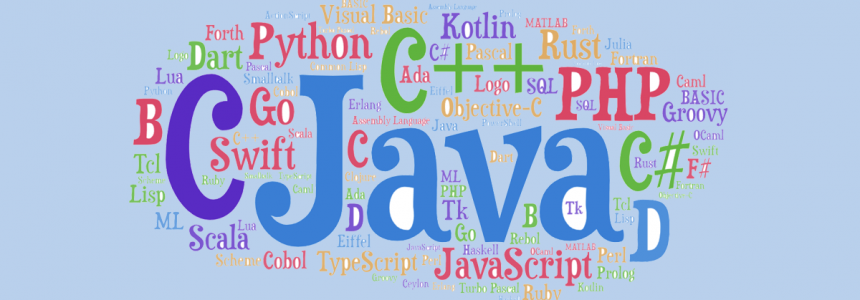
At the end of this lesson-
1. You will be able to describe programming languages of different generations.
2. You will be able to describe programming languages of different levels.
3. You will be able to explain characteristics, advantages and disadvantages of machine language.
4. You will be able to explain characteristics, advantages and disadvantages of assembly language.
5. You will be able to explain characteristics, advantages and disadvantages of High level programming language.
Go for Bangla Version
A computer system usually has two parts. One is hardware and ...
Read More
HSC ICT Chapter 5 : Comprehension Based Questions & Answers
How to write answers to a comprehension based question?
⇒ 'Comprehension' refers to the ability to understand the meaning of a topic. It can be the ability to understand any information, policy, formula, rule, procedure, process etc.
⇒ Perceptual level is the second level of thinking skills. This question is given in 'b'. Such questions do not directly ask for textbook-like details. So the student has to explain or describe the content in his own way.
⇒ Marks of comprehension based question will be 2. Out of which 1 is for knowledge and 1 is for comprehension.
⇒ Comprehension based q...
Read More
HSC ICT Chapter 4 : Comprehension Based Questions & Answers
How to write answers to a comprehension based question?
⇒ 'Comprehension' refers to the ability to understand the meaning of a topic. It can be the ability to understand any information, policy, formula, rule, procedure, process etc.
⇒ Perceptual level is the second level of thinking skills. This question is given in 'b'. Such questions do not directly ask for textbook-like details. So the student has to explain or describe the content in his own way.
⇒ Marks of comprehension based question will be 2. Out of which 1 is for knowledge and 1 is for comprehension.
⇒ Comprehension based q...
Read More
Fifth Chapter: Knowledge Based Questions & Answers
What is program?
What is programming?
What is programmer?
What is programming language?
What is 4GL?
What is high level programming language?
What is machine language?
What is assembly language?
What is mnemonic?
What is translator program?
What is assembler?
What is compiler?
What is interpreter?
What is debugging?
What is testing?
What is syntax error?
What is logical error?
What is algorithm?
What is flowchart?
What is pseudo code?
What is OOP?
What is variable?
What is constant?
What is keyword?
What is data type?
...
Read More
Fourth Chapter: Knowledge Based Questions & Answers.
What is web page?
What is website?
What is home page?
What is static website?
What is dynamic website?
What is URL?
What is DNS server?
What is IP address?
What is browser?
What is search engine?
What is internet?
What is WWW?
What is web server?
What is domain name?
What is web hosting?
What is HTML syntax?
What is HTML?
What is HTTP?
What are the advantages of HTML?
What is HTML element?
What is HTML attribute?
What is the function of HTML tag?
What is HTML tag?
What is container tag?
What is empty tag?
What is ti...
Read More
Sixth Chapter Lesson-8 : Database Relation and it’s classification.
At the end of this lesson-
1. You will be able to explain database relation.
2. You will be able to describe the conditions of database relation.
3. You will be able to explain classification of database relation.
Database Relation: Relation between records of a table with the records of another table of a database is called database relation.
Condition for making database relation:
There must have one common field between relational tables and data type, field size and format must be same for that common field.
There must have a primary key field on at least...
Read More
